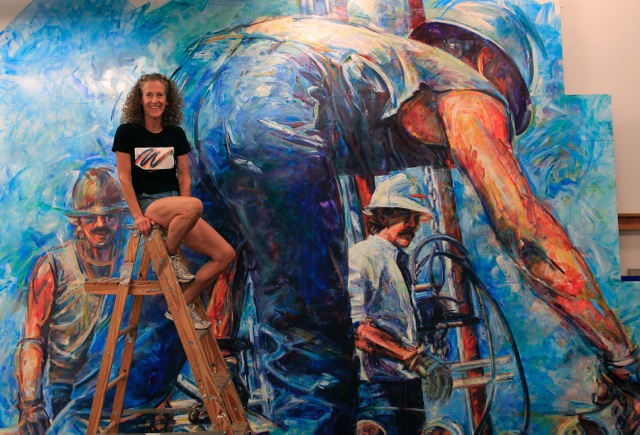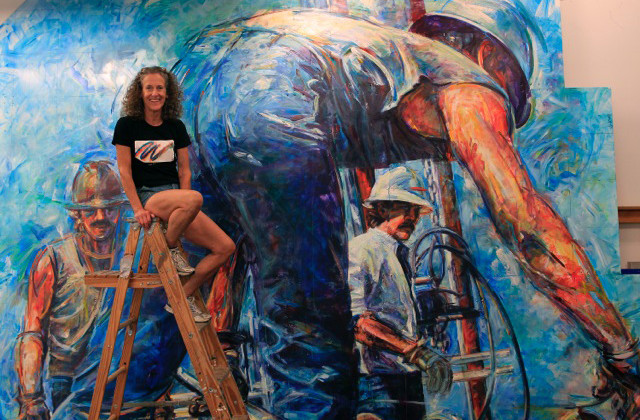Ellen Griesedieck’s Mural Project Celebrates the American Worker
By Ruth Melville

Ellen Griesdieck with a portion of the American Mural Project in her Sharon studio. Photo by Judy Griesedieck.
Ellen Griesedieck thinks big. Her latest project has been 15 years in the making and is five stories tall.
Griesedieck is the artist and driving force behind the American Mural Project. The three-dimensional mural, designed as a tribute to the working people of the United States, will eventually be 120 feet long, 6 feet deep and 48 feet high. Displayed in a restored mill building in Winsted, Conn., it will be the largest collaborative, indoor, three-dimensional mural in the country.
The mockups of the mural show a profusion of working men and women and the objects they create. The images include men drilling, foundry workers, a woman milking cows, tractor trailers, the George Washington Bridge, the Statue of Liberty, a rocket blasting into space, surgeons in an operating room, a jet plane engine, a piano, the Empire State Building, power lines, the wooden frame of a house, and much more.
Griesedieck first conceived of the project in 1999. She had been working on a series of paintings of working Americans when she realized that “our kids are growing up with no idea about the history of work in this country. I wanted them to learn about the ingenuity, the creativity we have, why people came to live here.”
The original design is Griesedieck’s, but she is making the pieces of the mural in collaboration with school groups from across the country. She started with eight local schools, but by now she has held workshops in 22 other states. Griesedieck likes to bring together children from different backgrounds, so for example she had a group from Hotchkiss working with kids from Harlem. The first piece of the mural was an eight-foot-high ceramic figure of a man working in a foundry. In all, 250 children worked together to create the figure from clay. All they had to start from was a tissue outline, to make sure they got the size right.
In Las Vegas, Griesedieck worked with Andre Agassi’s College Preparatory Academy. Kids were encouraged to bring in small objects, photos and drawings to press into wet spackle, which they then painted. The finished piece was displayed at the school before being sent off to Connecticut. A group of schoolchildren in Washington, D.C., from both public and private schools, did silk screens that were then exhibited in the atrium of the city’s Martin Luther King Library. Over 10,000 kids have worked on the mural project to date.
Griesedieck’s emphasis on collaboration has also led her to reach out to experts in a variety of fields. Her group of advisers, many of whom have become friends, includes the artist Frank Stella; Henry Petroski, professor of engineering at Duke University; the environmentalist and author Paul Hawken; Dr. Mehmet Oz; and the humorist and illustrator Sandra Boynton. The late Paul Newman was an early supporter. Once they hear about the project, Griesedieck says, “people want to be part of something that’s so good.”
A visitor to Griesedieck’s studio in Sharon, Conn., is stunned by the size, color and dynamism of the finished pieces of the mural. A brightly colored painting of linemen on honeycomb aluminum panels covers a wall from from floor to ceiling. Another equally large painting is of drillers in Colorado, dressed in jeans and hard hats. A painting Griesedieck calls “an ode to teachers” shows a class of students surrounding their beaming teachers. A ceramic cow leg, complete with grass on its hoof, lies in one corner of the studio, while the clay figure of the woman milking the cow lies on the floor nearby. Vivid orange and yellow resin sculptures of a rocket blast or a sluiceway of molten metal are propped against tables.
In 2006, the American Mural Project purchased two old mill buildings on Whiting Street, in Winsted, to house the finished mural. Local politicians, including Senator Chris Murphy and Congressman John Larson, heard about her project and encouraged her to apply for a state bond to begin construction.
Last September the state of Connecticut awarded the mural project a $1 million challenge grant. Griesedieck has until September 1, 2015, to raise the additional $1.4 million needed to get construction underway. Plans for renovating the buildings have already been approved by the city of Winsted.
The first phase of construction will raise the roof on the main building and build the structural armature for assembling the mural. The mural will be viewable on three levels and from the back as well as the front. Once the mural starts to go up, it will be open to public, so visitors can watch the progress of the installation.
In phase 2, the two buildings will be joined with a glass atrium. Griesedieck wants to use the second building as a visitors’ center, with rooms for lectures and workshops. She envisions kids coming to see the mural on school field trip and then staying on to make something themselves.
During the third, final stage of the project, native trees and shrubs from around the country will be planted on the property next to the two buildings. Griesedieck also hopes to have an amphitheater for outdoor concerts.
Although her project is small in comparison, Griesedieck can’t resist comparing it to the Massachusetts Museum of Contemporary Art (MassMoCA) in North Adams, Mass. She thinks the American Mural Project has the potential to attract visitors from across the region and thus have a positive economic effect on Winsted for years to come. A true celebration of the city’s industrial history.

